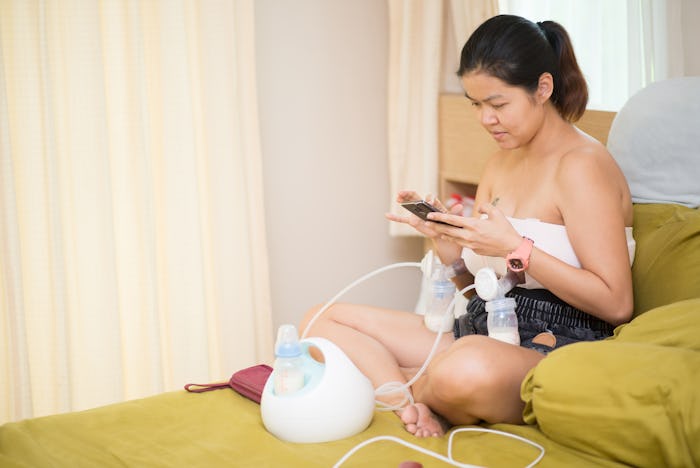Life

Sanitizing Your Breast Pump Every Day Is A Total Pain, But Here's Why It's Important
We get it, breast pumping is at once a lifesaver for nursing moms and a total pain in the butt. Aside from making you feel like a dairy cow, you can feel the hours of your life seeping away through those wheezing shields into the collection bottles, and that's not even taking into consideration the work when you figure out how often you should sterilize your breast pump. You might think that washing your hands and tossing the pump's bits and pieces into the sink for a soapy soak is enough to keep everything clean so you can move on with your day, but so did this mom who accidentally gave her preemie a very serious Cronobacter infection that resulted in cerebral palsy and developmental delays. According to the Centers for Disease Control and Prevention (CDC), breast pumps should be sanitized at least once a day to prevent household germs from resulting in tragedy.
But there's more. The CDC's breast pump regimen says that thorough cleaning before and after each session is particularly important for premature infants, those under 3 months of age, and babies with compromised immune systems. Those parents must sanitize their equipment daily to kill nasty pathogens that could land their baby in the hospital — or worse. Healthy infants are less susceptible to the germs after about 3 months of age, but regular sanitation is still recommended because duh — it's super nutritious, un-pasteurized body fluid your child is consuming.
So how scary are those germs lurking in a kinda clean pump? Very. Aside from Cronobacter, there are reported cases of group B Streptococcus, Listeria, Staphylococcus, Salmonella and tuberculosis, among many others. According to a study in the medical journal Clinical Microbiology and Infection, the likely source of all these illnesses was probably contaminated breast milk that resulted in sepsis in pre-term infants and in one case, death. The authors go on to say that in cases of premature infants, hospitals should consider routinely providing pasteurized breast milk from a milk bank to prevent maternal contamination.
While hospitals are vigilant about their own breastfeeding protocols to prevent infection, moms are on their own once they get home. Some of the steps that parents might overlook are hand washing every time you pull out the pump, using a dedicated wash basin — separate from the kitchen sink — that is kept immaculately clean, scrubbing thoroughly with a regularly sanitized bottle brush, and letting the parts air dry to avoid contamination from dish towels. The CDC recommends at several stages that a dishwasher can sanitize things pretty well. But the agency also points out that the tubing is very difficult to clean properly if it comes in contact with breast milk, so moms should keep back-ups in case it happens.
Moms who pump at work may find this time-consuming protocol to be a burden, but luckily, the internet has a few workarounds for older babies who are not as susceptible to infection as preemies and newborns. First, stocking up on breast shields and bottles lets you bring a supply of pristine parts that can be scrubbed properly when you get home. Second, Medela Quick Clean Micro-Steam Bags enable you to sanitize pump parts in the office microwave if waiting until evening isn't an option. And since breast milk itself is sterile and contamination comes from contact with other sources, some moms recommend stashing previously immaculate parts, secured in a resealable bag, in the refrigerator to inhibit bacteria growth between uses, according to Parents. It's a last resort, but a decent one. Taking the extra steps to be sure your baby is safe while getting the optimal nutrition she needs is a very involved process, but when everything is working properly and you take the time, it's totally worth it.